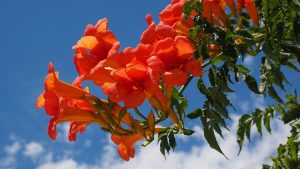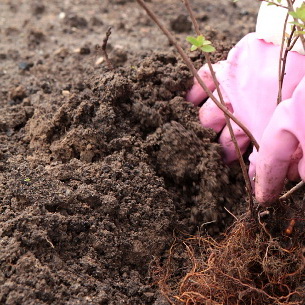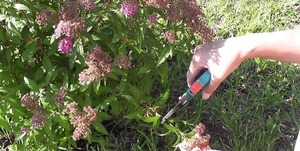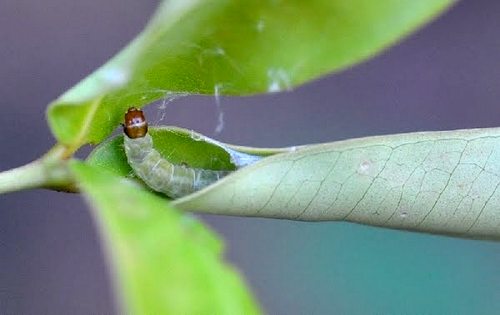Planting spirea
Boarding time
The best time to plant a spirea is September. Favorable weather is cloudy, or even better, rainy when the soil is well saturated with moisture.
Soil and size of planting holes
Spireas grow and develop best on loose, breathable soil with a lot of humus. Of course, plants will grow on poor soils, but in this case they will not be able to show all their beauty.
The size of the planting pits is determined as follows:
- If the soil on your site is exactly what the spirea likes, the planting pits should be 25-30% larger than its root system and 40-50 cm deep.
- If the land in place for growing is not entirely suitable, then it is advisable to dig a hole three times larger than the root system of the seedling. Both in width and depth.
The mixture, which will fill the pit, is made up of sand (river), peat and sod or leafy soil. Moreover, the land is taken in two parts, but sand and peat one by one.
The distance between the planting pits depends on the placement of the spirits and the flowering time:
- Summer flowering spireas, when planted in a hedge, are planted at a distance of 40-50 cm from each other, when arranged in several rows, the distance between rows is 30-40 cm.In a group planting, they maintain a distance of 50-70 cm, sometimes up to 1 m.
- Spring flowering spireas plant more freely. In hedges at a distance of 70 cm - 1 m, in group plantings - 1-1.5 m.For group planting, holes are dug at a distance of 50-70 cm.
Landing technology
Before planting, soil is first poured onto the bottom of the pit, and then a seedling is installed, all the roots must be straightened out, and only then everything is carefully covered with an earthen mixture.
The bush is planted so that the root collar (the junction of the trunk and roots) is located at ground level.
Before planting, the root system must be examined, broken and dried roots cut off.
If you are planting a seedling with a clod of earth, then after planting, good watering is carried out.
And if the root system is bare (without soil), then it is placed for 12 or 24 hours in a solution of water and a root formation stimulator. It can be heteroauxin, succinic acid, indoleacetic acid and other various preparations that can be purchased at any garden or flower center. Plants treated in this way are immediately planted in a permanent growing area.
You also need to recall one nuance that should be taken into account when preparing the pit for planting. Although spireas love moisture, there should be no water (underground or after rain) near their roots, in any case. Therefore, if planting is carried out in the ground with a large amount of clay, then drainage is necessarily poured into a hole (dug 2-3 times more than the root system of the bush). For this, gravel or crushed stone is usually used. The layer height should be 10-15 centimeters. Then soil is poured over the drainage, into which a young spirea is planted.

Reproduction
The shrub is propagated by seeds and vegetatively (by cuttings, branches, shoots).
Seed reproduction
The box is filled with good quality soil, ideally the leafy soil is mixed with peat. Seeds are evenly placed on the soil surface and sprinkled with peat 1 cm. After 7-12 days, you can see the first shoots, and this is the optimal time for Fundazol treatment. The box is removed in the shade, the soil mixture is regularly watered and loosened. And only after 60–90 days the seedlings are transplanted to the ridge. To make the plant easier to transplant, the roots are slightly shortened with a very sharp pruner. Before starting work, the cutting tool is treated with a pink solution of potassium permanganate.
Important! Seeds do not propagate hybrids and ornamental varieties.

Branches and branches
The organization of the diversion begins in early spring, immediately after the awakening of the kidneys. A long, healthy branch, intact by frost, is bent to the ground, the middle part of the shoot is sprinkled with earth, and the crown is attached to the support. In severe drought, not only the mother bush is watered, but also the rooting site. In order for the roots to form and grow more actively, all peduncles are removed from the branch (even before the beginning of flowering). The branch is separated only for the next year.
Info! Spirea gives a large amount of root growth, which takes root well after transplanting. A transplant (separation from the mother plant) is best done in early spring, a young bush may not survive severe frosts.

Green cuttings
It is carried out only in very cloudy weather, or during the period of shallow precipitation, when the air humidity is close to 100%. To begin with, they examine the mother bush, it should be distinguished by excellent health and development, be free of pests and diseases. For green cuttings, only cuttings that have formed this year are suitable. Last year's shoots are usually covered with bark in the summer, which will interfere with normal rooting. It is also not worth taking the top, it has an increased water content, therefore there is a great risk of sample decay.

We prepare the necessary tools at hand:
- 2 small containers;
- boiled chilled water;
- potassium permanganate;
- clean medical gloves;
- sharp quality pruning shears;
- white cellophane bag;
- a root growth stimulator of the Kornevin type.
Important! If the secateurs are not sharpened enough or cuts poorly, then all cuts are corrected with a sharp blade or scalpel. You need to cut the branches a little obliquely, then the formation of roots is more active, and the risk of decay is reduced .. Further algorithm for harvesting cuttings:
 Further algorithm for harvesting cuttings:
Further algorithm for harvesting cuttings:
- Mix water and potassium permanganate so that a light pink solution is obtained and pour it into a clean container.
- We put on gloves.
- We rinse our hands in water with potassium permanganate, this will help disinfect the glove latex.
- First, we cut large shoots, from which specimens can be prepared for rooting.
- Rooting specimens should be 7-9 cm long. The lower leaves are removed, and 2-3 upper leaves are cut in half. The planting material prepared in this way is immediately placed in a light pink solution of potassium permanganate. Even a little overdrying will reduce the rooting rate.

Soil preparation
Here is the algorithm of actions:
- We take equal amounts of sand and high moor or slightly decomposed peat. Mix thoroughly, remove all solid inclusions, knead the lumps. We put the soil mixture into the rooting container. It can be a flower pot, a basin, a bottle with a cut-off neck.
- We cover the inner surface of the container with a cellophane bag, fill up the soil by 5-7 cm, tamp it well. We take out the cuttings from the water, carefully brush off the remaining liquid and place them in Kornevin by 3-4 mm, then stick them into the prepared soil to a depth of 1.5 cm.
- We maintain a distance of 3-4 cm between the cuttings so that the leaves do not touch.
- Near each specimen, the soil is again compacted from all sides in order to achieve maximum contact of the plant with the soil mixture.
- The planting is immediately sprayed with a spray bottle. For spraying, take boiled, but already chilled water, to which dry garlic is added. For 1 liter of liquid, 0.5 teaspoon of garlic is enough.
Cover the pot with an opaque white bag and tie carefully to reduce moisture loss. The container is placed in partial shade, if desired, a white cloth can be placed on top of the film and carefully tied with twine. The first opening is done not earlier than in 12-14 days.

Geographic summary
Spirea got its name from the elasticity and flexibility of the branches.From the Latin language this word "spiraea" is translated as "spiral". And from the Greek "speira" - "bend". Indeed, a shrub is capable of bizarrely bending, growing in the right direction. In landscape design, it is often used as the basis for a hedge.

Lush and abundant flowering of the bush
The popular name of the culture is meadowsweet. The name "White Bride" is also found. According to data from the dictionary of V.I. Dahl, in the old days its thin shoots were used for the production of ramrods and whips.
A plant planted in a large group looks luxurious. A bush with single flowers looks no less impressive. An artistic approach to garden design will help you create a sophisticated composition from different specimens.

Spirea hedge
Spirea feels most comfortable in forest-steppe, semi-desert and steppe zones. It is found mainly in the Northern Hemisphere. The Asian southern border is the Himalayan mountains, the North American border is the territory of Mexico.
The plant is noted for its resistance to drought and severe frosts. Its soil-strengthening properties are highlighted. Some varieties are used as a source of medicinal raw materials, due to the presence of ascorbic acid, carotene, saponins and other medicinal substances in the composition.

Campsis: description, types, planting in the open field, reproduction and care of a beautiful liana (85+ Photos & Videos) + Reviews
Reproduction of spirea in spring by dividing the bush
Reproduction of spirea is carried out in several ways: by dividing the shrub, seeds, layering and cuttings. The first method is considered the most optimal and fastest. We will tell you how to propagate spirea in all ways.
A quick way to get an already mature plant. Reproduction of spirea by dividing the bush is carried out if the plant has reached the age of 4 years. It is divided into several smaller shrubs. If the plant is older, then this method will be extremely laborious: the roots have grown and formed a powerful system. Because of this, it becomes extremely difficult to remove the shrub from the ground and separate it.
Dig out a bush based on the size of the crown, plus half a meter. Don't worry if you break multiple roots during this process.
The root system must be immersed in water for several hours, until some of the soil subsides. Wash the remains under running water. This is necessary so that the earth does not interfere with the division of the shrub into parts. Otherwise, carelessness can damage the roots or divide them unevenly, as they tend to intertwine.
Divide the bush. Each part should have a couple of main branches and a good root system. After that, the plant must be prepared for planting. The roots should be made the same length and cut off small shoots.
Water immediately after planting. If the summer is hot outside, then you need to water every day, and in cool weather - once a week. If there is enough moisture, the plant will quickly take root and develop actively.


If the shrub has outgrown the age of 4 years, then you should use other methods.
Spirea care
 The basic requirements for caring for this plant are as follows:
The basic requirements for caring for this plant are as follows:
- High quality drainage. The plant does not like excess moisture.
- Fertile and loose soil.
- Adequate sunlight.
- Mandatory soil mulching after planting.
Since this plant has shallow roots, it needs a lot of water. In the dry season, it is recommended to regularly water the spirea bushes. On average, one bush should take 32 liters of water. 16 liters 2 times a month.
It is advisable to regularly loosen the soil around the bushes and remove weeds in a timely manner.
Good care is impossible without top dressing. For this, it is recommended to use mineral fertilizers. You can also use mullein solution.
As for pruning, it should be done in the spring and fall. It is mainly of a sanitary nature. Also, bushes can be pruned when they are overgrown.
General information about sulfur spirea
Spirea gray grefsheim is a fast-growing shrub that is easy to care for and has excellent decorative effect. In ancient times, spirea and its many varieties were used to make wickerwork and whips. Subsequently, this plant was used exclusively in landscape design, allowing you to equip hedges and decorate the backyard area.
A variety of sulfur spiraea was bred in Norway in 1949 by hybridizing St. The shrub, according to its description, is distinguished by its strong branching, its shoots are felt ribbed. The foliage is greenish-gray, the lower part is much lighter than the front side. Flowering begins in May and continues for several weeks. Flowers are white and milky in color, located in loose shields. The height of the bushes, depending on the age of the plants, can reach 90-200 centimeters. The first flowers on the shrub appear in May, and in June the first ornamental fruits are already formed.
Currently, there are various varieties of sulfur spirea. A hybrid called gray spirea Grefsheim is very popular. Also this variety is often called May snow and Bride. This plant begins to bloom in May and is literally dotted with numerous white flowers for several months. Shoots of gray Grefsheim spirea are arched with numerous double white flowers. The crown of the gray Grefsheim spirea is spreading, vaguely resembles a small fountain.
Gray spirea grefsheim grows annually to a height of about 25 centimeters, and after 3-4 years it reaches 150 centimeters. Note that the flowers of this shrub are an excellent honey plant, attracting a variety of pollinating insects to the garden beds.
Application in garden design and combination with other plants
Spiraea gray and its varieties are perfectly combined with almost all types of plants that are used for landscaping and decorating gardens, parks, home gardens. For single and group plantings, neighbors are selected taking into account their size, shape, flowering time, color palette of foliage and flowers, using spirea bushes as the center of the composition and for arrangement.
The combination of spirea with conifers and evergreen shrubs, for example, juniper, will add oriental motives to the ensemble of these plants. The spirea bush will look even more elegant against the background of viburnum, lilac, broom. On flower gardens of all formats in front of municipal buildings and in city squares, spirea bushes next to different types of roses or any other flowers, for example, tulips, crocuses, alissums, visually add volume and expressiveness to them. The combination of species and varieties of spirits with different flowering periods allows you to admire flowering plants for 4 - 5 months in a row.
In order to hide a fence or other outbuildings at a summer cottage from eyes, dense and tall bushes of gray spirea are one of the most optimal options. They are able to add splendor to any mixborder, enhance the festive beauty of borders and alleys, emphasize the romantic power of giant trees. But a dwarf or low-growing variety of gray spirea is perfect for arranging an alpine slide and rockery. And, of course, flowering spirea branches are an excellent material for floristic compositions and bouquets.
What are plants afraid of?
Spirea, in fact, rarely gets sick, however, it is not immune from the attack of pests, like any other green plant. Bushes attack most actively:
1. Aphids.
2. Spider mite.
3. Leafworm.
The latter appears in May. Its caterpillars are so gluttonous that they can destroy up to 60% of the crown, gnawing juicy leaves along with pedicels. You can fight the leaf roll with the Primor preparation in 0.1% concentration. Its use in 95% of cases helps to get rid of pests in one spray.

Leaf roll on Japanese spirea leaves
The most dangerous enemy of spirea is the spider mite. Its appearance is evidenced by a light cobweb in the crown and holes in the inflorescences. The leaves of the affected plant will dry out and fall off for no reason. The parasite is most active during the dry season. You can effectively fight spider mites: 0.15% phosphamide solution, 0.2% acrex solution or good old karbofos in 0.3% concentration.
Japanese spirea affected by spider mites
Preventive measures to prevent the attack of pests are regular loosening of the soil, proper watering, and timely feeding.


